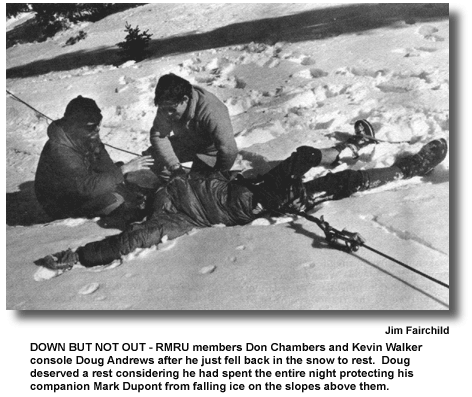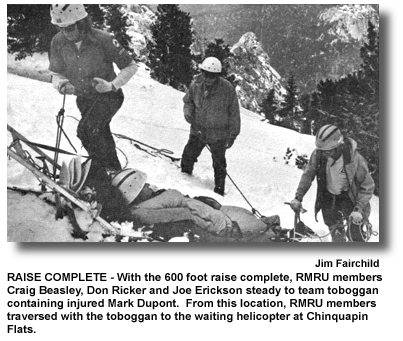Pair slid 300 and 800 feet
|
March 22, 1980 |
 |
By Walt Walker
Mother Nature has been good to the mountains this winter, a heavy blanket of snow covers them. Three young men, Doug Andrews, Mark Dupont and Rick Kierstead decided a one day cross country ski tour in the San Jacinto Mountains would be a great way to spend a Saturday.
It had been a good day and the trio were skiing along the northeast Tahquitz ridge. As Mark was traversing a slope, he came upon some water ice, hidden by a layer of loose snow. Then ... slipping, sliding, tumbling, he finally crashed into a tree 300 feet below. Doug started down to help and ... he also slides and tumbles, traveling 800 feet, but fortunately he does not crash into anything solid.
Mark has probably broken his leg and wrist. Doug is luckier, he is only bruised scratched. Shouting back and forth, it is decided that Rick will go for help and Doug will do what he can for Mark.
About 6 p.m. RMRU was called by the Hemet station of the Riverside County Sheriff's Department. Before the night was over 17 RMRU members and three Hemet Search & Rescue Team (HSAR) members were involved.
As rescue team members arrived at the Idyllwild sheriff's office, a plan of action was drawn up. (After talking to the informant, Rick Kierstead.) Part 1 - Kevin and Walt Walker (RMRU), Chuck Benson and Steve Vaugh (HSAR) became the "bash team", (first responders who give first aid, access the situation and radio out for needed equipment). Part 2 - The balance of the unit members became the "sherpas", (members who carry heavy packs and in this mission, they were to also pull in the rescue toboggan).
At 8 p.m. Chuck, Steve, Kevin and I left Humber Park and started hiking. We quickly left the Devil's Slide Trail and turned towards Tahquitz Ridge. In 10 more minutes we were in the western drainage below Chinquapin Flat. Climbing up and away from the stream, the snow became very hard and we stopped and strapped crampons to our boots.
We had no sooner done this when we heard voices. We first thought, somehow Doug and Mark had worked their way down. Hiking a little further on, we met three young men. (See the following write-up.)
The four of us continued hiking up the canyon. As the angle of the slope increased, we were no longer hiking, we had begun to climb. just about 10 p.m. we received a response to one of our shouts. It was Doug and Mark and we saw the dim glow of a flashlight, far above us. It appeared to be about 300 feet below the ridge line.
With the pair only a short distance below the ridge and the fact that the group bringing up the rescue toboggan was not very far up, it was decided to have them descend. They turned around and left the toboggan at base and started up the Devil's Slide Trail to hike the Tahquitz Peak Trail over to Chinquapin Flats.
The angle of the slope was now about 30° and we had begun to find water ice under about three inches of loose snow. At about 10:30 p.m. I was leading our group when ... the world turned upside down. I had lost my footing, tumbled downslope, crashed through a small Pine tree, dropped off a three foot ledge, struck my head and elbow, slid 50 feet in the ice axe arrest position on water ice, and finally came to a stop. In the process I had torn a pocket open on my pack, broken the radio antenna and my headlight and found that I had abraded my forehead and elbow enough to bleed.
After I had assured everyone I was o.k., the four of us continued upward. We stopped and I roped up to lead up a steep icy chute. Belayed, I started up and in a short time I was chopping steps in the ice. Then the world began to turn around and a wave of nausea swept over me. I fought back the urge to vomit and forced myself up another six feet and swung my leg over a rock. I slumped down onto it. I yelled down that I was not feeling well and I would go up ten more feet to a tree and tie the rope to it. Slowly and carefully I chopped steps up to the tree and secured the rope to it.
(Editor's note: Walt's condition continued to deteriorate. His conscious level dropped, he didn't know where he was or what was going on, etc. He began to shiver and complained of a severe headache. It began to appear that he might have suffered a head injury during the fall. At about 3 a.m. he was placed into a sleeping bag. At base, Jim Fairchild began to call for more manpower and requested a helicopter for use in the morning.)
A little after 5 a.m. I woke up, found myself in a sleeping bag and had a headache. Although I couldn't remember getting into the sleeping bag, I sure could recall why I had a headache. I radioed base and was advised that a Hughes 500D from Western Helicopters, in Rialto, was due in at 6:30 a.m.
When the helicopter arrived it was put to use hauling two loads of RMRU members and equipment to Chinquapin Flats. They immediately started working there way down towards Doug and Mark. The bird then put one runner down, picked up Chuck and 1, then Steve and Kevin in a second load. The helispot was one of the more Interesting ones on the mountain.
Chuck and I started down slope and watched as John Muratet and Larry Roland set up a hand line over to the victims. We clipped onto the rope and followed over to the accident site.
 While this was going on the group
that had gone up the Devil's Slide arrived along
with more helicopter loads of men and equipment.
They began to set up a rope system that would be
used to lower and then lift the rescue toboggan.
While this was going on the group
that had gone up the Devil's Slide arrived along
with more helicopter loads of men and equipment.
They began to set up a rope system that would be
used to lower and then lift the rescue toboggan.
As Chuck and I sprinted Mark, the toboggan was lowered, along with Joe Erickson guiding it, 600 feet down to us. A platform for the toboggan, just above Mark, had previously been chopped out of the slope. A stove had been started and warm liquids were given to Mark and Doug.
Larry and Joe helped Doug into a sit harness and then clipped him onto the rope that had been used to lower the toboggan. Using Jumars (mechanical ascenders) the three of them went up the rope. (Doug was flown out shortly after arriving at the top.)
With splinting completed, Mark was lifted into the toboggan and carefully secured into it. As Joe, Chuck and I moved the toboggan into a vertical position, what had been an irritating problem, turned into a life threatening situation. Earlier, as the sun rose, it had began to melt the ice clinging to the trees above us. At first small pieces tumbled down, then larger chunks and now, huge blocks of ice came hurtling down at us.
As we tried to protect Mark, Joe was struck in the wrist by a large piece of ice. Shortly a block plowed into my shoulder and knocked me off my feet. I had no sooner gotten to my feet, when another barrage hit us. This time Chuck was struck by a large block, right in the lower
back area just at kidney level. He was also knocked from his feet and lay moaning on the snow. I dropped down to him and asked how he was, obviously in pain, he said he could continue. I shouted into my radio microphone, "get us the hell out of this shooting gallery".
Rick Pohlers radioed back that they were just starting the lifting process. With Joe and I on the front, of the toboggan and Chuck at the rear, the lift began. The team members at the top pulled and struggled on the rope. The toboggan would go up about 25 feet and stop. They would take another bite with the mechanical advantage and 25 more feet would go by. It takes a long time to go up 600 feet, 25 feet at a time!
 It was noon when we completed the
raise and everyone was exhausted. However, our
job was not done yet. After fighting ice and
steep slopes, we now had to struggle through knee
deep soft snow, dragging the toboggan about a
quarter of a mile over to Chinquapin Flats.
It was noon when we completed the
raise and everyone was exhausted. However, our
job was not done yet. After fighting ice and
steep slopes, we now had to struggle through knee
deep soft snow, dragging the toboggan about a
quarter of a mile over to Chinquapin Flats.
Once there, we loaded the toboggan into the back of the helicopter. Brian Hixson climbed in the back also, to keep an eye on Mark during the flight to Camp Maranatha in Idyllwild. The Loma Linda Hospital helicopter was waiting and Doug and Mark were loaded into it and sent to the hospital.
A very tired and weary group started coiling ropes and collecting up equipment. The gear, along with members, was flown out in a number of trips. Jim and I were the last load out and it was 2 p.m. as we climbed out of the bird.